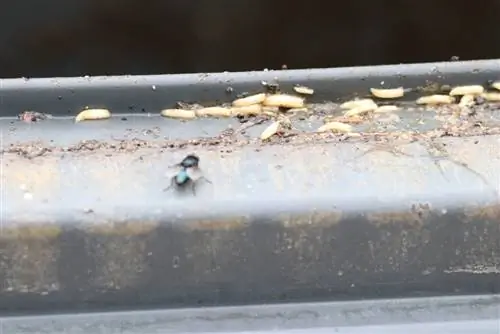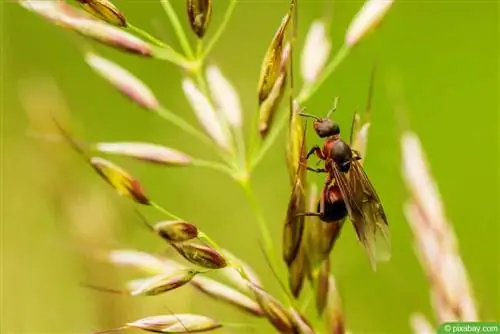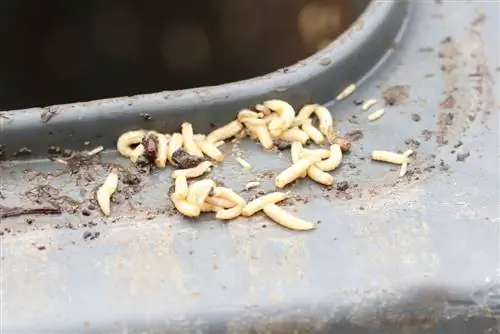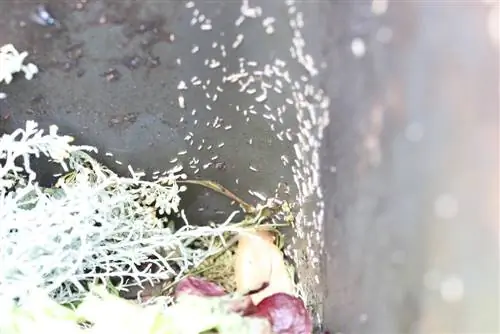- Author admin [email protected].
- Public 2023-12-17 03:39.
- Last modified 2025-06-01 06:48.
The mind says: A few cells of protein, freshly born=harmless. The feeling says: snakes, worms=get rid of that stuff, IMMEDIATELY! Getting rid of the stuff isn't a problem; Even proven snake phobics dare to approach tiny maggots under the protection of cleaning supplies. The problem may be that new maggots appear after cleaning, the article will lead you on the trail of this recurring nuisance. You will also learn how to get rid of the maggots forever or how to prevent “increased maggot numbers” in the future:
What are maggots and how do they get into the apartment?
Maggots are the children of flies that are applied directly to the home in the form of eggs. There are a few hundred eggs, and small, white maggots crawl out of all of these eggs. Animal food is typical, but female flies lay their eggs in any type of organic material that is currently or soon to be decomposing and in which larvae can develop (usually it requires a little protein).
In the summer months, the females lay several times and the eggs develop into newly hatched larvae in one day. Which can sometimes feed themselves splendidly, e.g. B. from the animal feed in the film. If the mother fly has not found a good opportunity to lay eggs, the birth environment e.g. B. consisted of a tiny bit of chocolate, the larvae will soon have to go looking for food. What they do - even though they are called maggots because they are headless and legless, they can move by bending their bodies. This is exactly when the maggots appear in the most unlikely places (which we'll get to).
If the maggots have good living conditions (which requires tiny amounts of food), they can multiply explosively. The quickest way to find the origin of the plague is to search specifically, and we are now introducing the four species or families of flies that often lay eggs in apartments in our latitudes:
Real fly, e.g. B. Houseflies
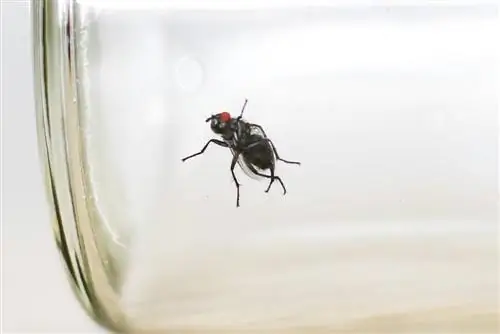
Almost one centimeter tall, shimmering brown to black and well known. Female house flies are attracted to any food that contains trace amounts of butyric acid or sugar. So almost all foods - butyric acid is found as an ester in every fruit and in every rotten part of food or fodder (and in small animal feces, etc.); 98% of all industrially produced foods contain sugar, even if they are not sweets. Since a spot of ketchup or chip crumbs is enough to lay eggs, the birth of maggots can also take place under the living room sofa; In a kitchen (that is normally run in a relaxed manner until the maggot infestation occurs) there are definitely enough leftovers.
Meat flies
Mostly gray to anthracite iridescent and a little larger, the adult flies, contrary to their name, feed on sweet juices, honeydew, nectar, fruit juice, jam. The female flies actually lay their eggs on feces or carrion, but if they're in the apartment (and can't find a litter box or small animal cage), it can also be a rotten slice of sausage in the trash. The maggots are responsible for the naming, and immediately after hatching they set off in search of living food.
Christmas flies
Millimeter-sized animals that are also known as fruit flies, fruit flies, fermentation flies, must flies, vinegar flies and are annoying. The adults (adult flies) eat the microorganisms that cause fruits and fruit-containing drinks to rot or ferment; The eggs of the next generation are also laid there. The maggots eat the same things as the adult flies and can therefore be found on the marmalade spot or on the leafy plant with rotting shoots.
Blownflies

A little larger than houseflies, they usually have a metallic blue or green iridescence. When they appear in large numbers, there is usually an animal carcass nearby, where they prefer to lay their eggs. But other organic substances also do it, and a female fly in distress (=no good nest in sight, e.g. because she is “trapped” in a clean apartment by closing the window) keeps the eggs in herself until the eggs develop is so advanced that she can lay the maggots directly.
Now you know how the “white worms” get into the apartment and why they run around; the maggots themselves can simply be swept onto a dustpan and disposed of in the garden to the delight of the birds (or have developed in the rubbish they are brought out with anyway).
Cleaning away maggots - the right way
Perhaps you had to remove organic residues or waste, perhaps the fly attraction was eliminated before the maggots appeared; In any case, most people feel a significant need to clean the areas where the maggots have been spotted. Do this, but so thoroughly that this area no longer invites you to lay eggs:
- If the maggots were in the trash can, clean it thoroughly using something that smells as artificial as possible
- Double rinsing with vinegar (acidic) and soda (basic) will certainly eliminate all traces of attractive odors
- If the maggots have sat in the trash bag (repeatedly), changing the brand to thicker trash bags sometimes helps
- If the maggots were running along the floor, apply as artificial a scent as possible after cleaning
- Don't you have artificial scents in your household? What about aftershave, washing powder, rubbing alcohol?
- Maggots spotted on ceilings or walls usually leave no trace
- At most, a little perfume can be sprayed here, which gives a “clean feeling”
- In really hard-to-reach corners, you can get rid of the maggots with a hot air blower
- In large office floors, such a maggot infestation is “killed” with a professional hot air blower
- In a normal household environment with the household variant, also known as a “hair dryer”
- Make sure that the hairdryer is in the normal position (which is not gentle on your hair), so it gets really hot
You don't have to worry about germs being transmitted by maggots. It is true that flies can transmit germs because they may have landed on germ-contaminated material before flying into your home. However, if you are a statistician and you make a calculation about what the probability is that the fly is carrying unusual germs in such quantities that the immune system is overwhelmed - and you do the same calculation for people on the subway, you will see that the subway is much more dangerous. However, the maggots are born almost germ-free and, as natural waste disposers, spread so many antibiotic, antiviral and antibacterial substances when they eat that they are even considered one of the last resorts for healing poorly healing human wounds.
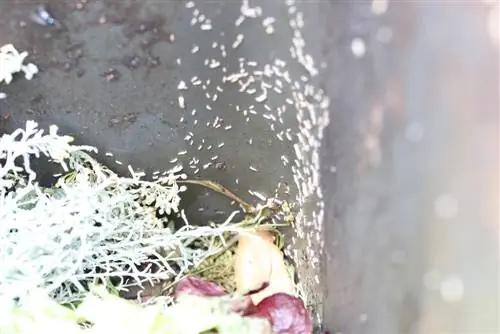
But the maggots are not the work of the devil either, on the contrary: as soon as they hop from the dustpan into the garden, they become very useful there. Either “passively”, as food for lizards, frogs, birds, fish, spiders, dragonflies, wasps, praying mantises, shrews, or actively: they decompose decaying matter and excrement and are therefore part of the natural he alth police, and they turn this organic material into something very important, the fertile soil (humus).
New maggots? Search stove
Once you have discovered and eliminated a few maggots, sometimes new maggots appear “seemingly out of nowhere.”If this happens several times, it is an indication that “there is something in nothing,” because the maggots do not arise from nothing, but from eggs, and eggs are usually laid on organic matter. So you have to look for the organic mass that encourages the flies to lay eggs again and again, which can be detective work (especially in a winding half-timbered house or old urban building). Because a mother fly doesn't need a 250 g steak to lay her eggs; Any scrap that falls off your plate is enough for her.
When mom fly lays her eggs, she also likes to use any cracks, and the squeezeable and stretchy eggs are supposed to fit through surprisingly small holes. Since houses (especially old buildings) are not nearly as dense as some residents assume, maggots can be spotted in the most unlikely places: on the ceiling, because the eggs were buried in a crack in the room above; in the middle of the living room under this ceiling because they couldn't hold themselves there and fell down; on the wall because the spaghetti sauce blubbered and splattered while cooking.
If you've searched every crevice in a clean apartment and still haven't found anything, it could be an external problem: Maybe the snack bar downstairs shared the household garbage cans, and it's already getting so cold at night that the many Flies that “party there” like to go to warm rooms in the evening and there is a troubled mother fly who gives birth in an emergency in the nearest corner - when in distress, “nature” becomes very inventive, and for a fly the whole thing is no fun, but rather It's about the survival of the species. Speaking of the survival of the species - as gruesome as it is, in our big cities we always have to remember that a poor old person died unnoticed in another apartment in the house.
Worms, larvae or maggots?
The differences to the maggot are subtle. Larvae are intermediate developmental forms that are formed by insects, amphibians and egg-laying fish and are not always called larvae. Larvae of frogs are called tadpoles, larvae of tapeworms are called fins, the different larval stages of the egg-laying fish are called L1, L2 ff. Larvae of insects are called caterpillars or maggots, whereby the name caterpillar refers to the (small, green, voracious) larvae of butterflies and the name After caterpillar is reserved for the (small, green-patterned to colorful, voracious) larvae of plant wasps.
Maggots are larvae of dipterans that, unlike other insect larvae, are headless and legless, while the normal larva has a head capsule and limbs. In between there are maggots with heads but no legs (e.g. in ants, bees, longhorn beetles) and maggots with heads but fake legs (some mosquito maggots have stubby feet). Worms are real animals, with an elongated body and a crawling mode of movement, which you will most likely encounter as a pest in your intestines (tapeworm) and not in your home. Everything except worms is eliminated as described here; Only larvae and caterpillars can be found in other places: larvae (of beetles) in the bed box, caterpillars (of food moths) in still-packaged flour, muesli, nut snacks.
Fighting maggots and flies
The maggots themselves are ultimately combated when cleaning away. Maggots are brought into the house by flies and will become flies again if they don't get rid of all the maggots while cleaning; So it's actually about fighting flies.
Fighting flies?
Fighting the sun, the clouds, the moon? You certainly won't be able to prevent the occasional fly from "invading your home" if you don't want your home to be a clean room with air locks. But you can do a lot to ensure that flies are rare and, above all, isolated guests in your apartment.
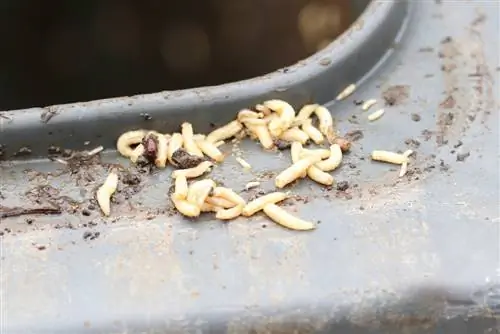
It's not the least bit about cleanliness - it's not unhygienic, but cozy and he alth-promoting when there's a plate of fruit on the table in the kitchen. But this fruit plate is best left in the fridge or under a peppermint-scented gauze cap on muggy August days. Just one example of many, overall it's actually about the famous mindfulness; here opposite your own household:
- Find and remove fly attractants, from open food in the kitchen to leftover food in the rest of the apartment
- Empty and clean garbage cans, clean animal toilets and enclosures more often
- Check inventory and repack food in bags/film into sturdy containers
- Tidy up accumulated “clutter corners” etc. and clean them
- Distribute or plant anti-fly scents throughout the household, including in the bed in front of the house
- Vinegar, basil, peppermint, lavender, laurel, frankincense, eucalyptus, geraniums, marigolds and much more should prevent flies from smelling
- For a complete list of application examples, see article “Maggots in the kitchen - this helps with maggot infestation in the house”
- Fly screens, adhesive strips and well-distributed fly swatters help with the mechanical defense against flies
- Place garden ponds and water pools at the back of the garden, keep the area around the house as dry as possible
- Spiders are natural enemies of flies, the more spiders, the fewer flies in the house
- Chemical control agents can help in an emergency, but they usually also contain poisons that are critical for humans
- In an emergency, biological defense with commercial parasitic wasps is better
Tenant's rights in the event of maggot infestation
If you often see maggots in an apartment, but there is no “nest of maggots” to be found, the landlord will have to get involved at some point. However, there must be significant amounts of maggots; a few animals that appear at large intervals could be tolerated as a normal phenomenon (such as vermin, the appearance of which is to be expected depending on the location/conditions of the rental property, e.g. ants, spiders, beetle at the house with garden).
If the vermin get out of hand, it represents a defect in the rental property. Then an exterminator has to go looking for where the maggots developed, who can then, for example, B. tracking down animals that have died outside the apartment or taking apart paneling in the hallway. The landlord must bear the costs of using the pest controller if the cause of the maggot infestation is within his sphere of responsibility. This is e.g. B. the case when the pests migrate from other apartments, the cause of the vermin infestation cannot be clarified, or it is certain that one of several tenants is responsible for the vermin infestation, but it remains unclear which individual tenant is the cause. If the landlord claims that you as a tenant were responsible for the vermin infestation, he would have to prove this in the event of a dispute.
However, as a tenant, you also have certain obligations: You must keep your apartment so clean that vermin cannot spread, which, according to case law, for example: This includes, for example, not leaving food out in the open in the apartment. You must also be able to prove that you have made serious attempts to eliminate flies, moths, beetles, etc. yourself, using all common commercially available tools. If the landlord takes action, he may not use every aid; Landlords have already been ordered to pay damages for bodily harm because they sprayed harmful chemicals into apartments. As always, however, the dispute involves considerable risks, which is why an amicable settlement is preferred.

